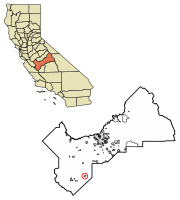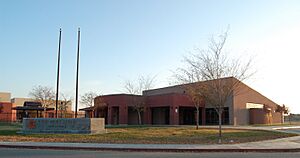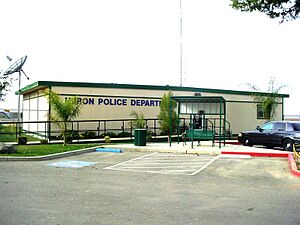Huron, California facts for kids
Quick facts for kids
Huron, California
|
||
|---|---|---|
| City of Huron | ||
|
||

Location of Huron in Fresno County, California.
|
||
| Country | United States | |
| State | California | |
| County | Fresno | |
| Incorporated | May 3, 1951 | |
| Area | ||
| • Total | 1.60 sq mi (4.14 km2) | |
| • Land | 4.14 sq mi (4.14 km2) | |
| • Water | 0.00 sq mi (0.00 km2) 0% | |
| Elevation | 374 ft (114 m) | |
| Population
(2020)
|
||
| • Total | 6,206 | |
| • Estimate
(2019)
|
7,281 | |
| • Density | 3,879/sq mi (1,499.0/km2) | |
| Time zone | UTC-8 (PST) | |
| • Summer (DST) | UTC-7 (PDT) | |
| ZIP code |
93234
|
|
| Area code(s) | 559 | |
| FIPS code | 06-36084 | |
| GNIS feature IDs | 1652725, 2410081 | |
| Website | http://cityofhuron.com/ | |
Huron is a small city located in Fresno County, California, in the United States. In 2010, about 6,754 people lived there. This number can grow to over 15,000 during harvest season because many farm workers come to help. Huron is about 15 miles (24 km) east-northeast of Coalinga and is 374 feet (114 m) above sea level.
Contents
Geography and Climate
Huron covers about 1.6 square miles (4.1 km2) of land. It does not have any large bodies of water. The city has a semi-arid climate, which means it gets very little rain. This type of climate is often found in dry regions, like deserts.
History of Huron
Huron was founded in 1888. It started as a stop for trains along the Southern Pacific Railroad. One of the first buildings was the Huron Post Office, which opened in 1877. Huron grew quickly in the early 1900s and has continued to expand. During World War II, Huron was home to three training airfields. These were called Huron Field, West Field, and Indian Field. They were part of a larger military base called Lemoore Army Air Field.
Important People in Huron's History
Joseph Mouren and his family helped Huron grow a lot in the late 1800s and early 1900s. They invested in the city, helping it become what it is today. A street called Mouren Drive is named after Joseph Mouren. Many people see him as one of the city's founders. In the early 20th century, Huron became a major producer of wool in the United States.
Population and People
| Historical population | |||
|---|---|---|---|
| Census | Pop. | %± | |
| 1960 | 1,269 | — | |
| 1970 | 1,525 | 20.2% | |
| 1980 | 2,768 | 81.5% | |
| 1990 | 4,766 | 72.2% | |
| 2000 | 6,306 | 32.3% | |
| 2010 | 6,754 | 7.1% | |
| 2019 (est.) | 7,281 | 7.8% | |
| U.S. Decennial Census | |||
In 2010, Huron had a population of 6,754 people. Most of the people living in Huron were of Hispanic or Latino background, making up about 96.6% of the population. The average household in Huron had about 4.41 people. Many households had children under 18 living in them. The median age in Huron was 24.7 years old, which means it's a relatively young community.
Huron is surrounded by farmland. Farmers in the area grow a lot of lettuce, onions, and tomatoes. During harvest time, the city's population can increase to over 15,000 people. This is because many farm workers come to help with the crops.
Schools in Huron
Huron is part of the Coalinga-Huron Unified School District. The schools in Huron include:
- Huron Elementary School (for students in Kindergarten through 5th grade)
- Huron Middle School (for students in 6th through 8th grade)
- Fresno EOC Headstart Program
- Fresno-Madera Migrant Headstart Program
Huron Police Department
The city of Huron has its own police department. This department helps keep the community safe and enforces laws.
Water Challenges
In 2009, there were problems with water supply in Huron and the surrounding farming areas. This happened because the government reduced the amount of water pumped for irrigation. This was done to protect certain types of fish. Because of less water, some farms dried up, and many people lost their jobs. Unemployment in the area went up to over 40%. This issue was discussed on TV news shows. Some people, including the governor at the time, felt that protecting fish was being put before the needs of people. Others argued that protecting fish would help jobs in fishing and tourism in the long run.
Images for kids
See also
 In Spanish: Huron (California) para niños
In Spanish: Huron (California) para niños








